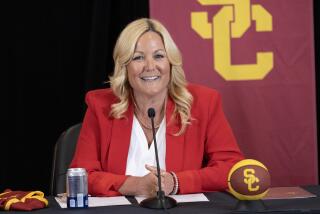Brand Doesn’t Veer From His Support of Title IX
LA JOLLA — Not long after taking over as NCAA president, Myles Brand said a prime advantage of the job was “the bully pulpit” it offered.
It’s clear that pulpit travels.
Brand was at it Monday offering a spirited defense of still-controversial 30-year-old landmark civil rights legislation on the first of a two-day Title IX seminar.
“My message today is the same as it has been over the last four months,” Brand said. “Title IX is not broken, and it does not need to be fixed. Rather, it needs to be supported, enforced and allowed to finish the job it was designed to do -- provide equal opportunities for athletics participation without gender bias.
“Now is not the time to say, ‘Close enough.’ Now is the time to say, ‘Close the gap.’ ”
Title IX has been the topic of renewed debate in the two months since a report was issued by the Secretary of Education’s Commission on Opportunity in Athletics. What precisely Rod Paige, the secretary of Education, intends to do with the committee’s recommendations has the NCAA holding its breath.
Paige has said he will consider only those recommendations that were passed unanimously by the committee. But even some of those have sparked debate because of the way they were presented in the report. Committee members Donna de Varona and Julie Foudy released their own minority report, stating that many of the commission recommendations would seriously weaken Title IX.
For example, they asserted that Recommendation 23 -- which suggested additional ways of demonstrating equity beyond the existing three-part test should be explored by the Department of Education -- afforded Paige an “open-ended invitation to add new ways to comply with Title IX.”
In an interview after the general session Monday, Brand said he also had reservations with 23.
“I am concerned about the last recommendation, 23, which is a very open-ended recommendation,” he said.
“It may be fine or may not. It’s just that it is too vague compared to the other recommendations.”
He cited progress in his state-of-Title-IX speech, pointing out that nearly 150,000 women are competing in NCAA sports and that women account for 41% participation and receive 42% of scholarship dollars, according to a recent survey. In 1971-72, before Title IX was enacted, fewer than 30,000 women participated, compared to 170,000 men.
“The cutting of the [men’s] programs is an issue that keeps being brought up,” Brand said. “What was correctly answered by [Stanford Athletic Director] Ted Leland is that those are individual institutional decisions that institutions must make, especially in tight budgetary times, how they want to allocate their resources.
” ... What you also heard today and what was testimony to the commission, when the ADs were asked, ‘If there was more money available to men’s sports, would you reinstate the sports you cut?’ And they said, ‘Not necessarily so.’
“So there’s something else going on here.... I don’t think you can blame this on Title IX. There are some institutional issues about which sports are being chosen for support.”
More to Read
Go beyond the scoreboard
Get the latest on L.A.'s teams in the daily Sports Report newsletter.
You may occasionally receive promotional content from the Los Angeles Times.











